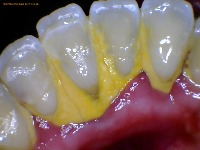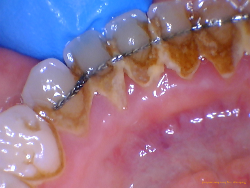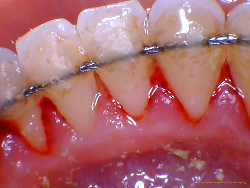Dental Cleaning (Teeth Cleaning): Things To Know
- David Chen, DDS

- Nov 10, 2023
- 9 min read
Updated: Jan 8, 2024
A dental cleaning is a procedure that is performed by a dentist or hygienist to remove plaque, tartar (calculus), and extrinsic stains from the teeth. A teeth cleaning is also known as a prophylaxis or "prophy" for short.

Table of Contents:
What would a dental cleaning do for me?
Dental cleanings are considered a prophylactic procedure which means that their primary purpose is in the prevention of gum disease. Although they're meant to be preventative, they can still be used to treat mild gum disease.
Conditions it treats
Removing plaque and tartar. Plaque is soft and can be removed by gentle brushing but once it hardens and calcifies into tartar, only a dental cleaning can get rid of it.
Eliminate extrinsic staining on teeth. These stains cover the exterior of the tooth and that means it can be mechanically removed by scaling. Teeth cleanings will whiten your teeth mechanically but not chemically.
Gingivitis. When given enough time, tartar and plaque that is left on your teeth will cause gum inflammation. By periodically removing them, you can reduce or prevent the gingival inflammation.
Treats mild gum disease like gingivitis. Mild gingivitis can be successfully treated by getting a cleaning. The source of the gum inflammation stems from untreated calculus and by getting rid of it, you can also get rid of gingivitis.
A commonality among these conditions is that a dental cleaning can be used to either prevent or treat mild conditions.
What it cannot treat
Moderate-severe gum disease like periodontitis. Untreated gingivitis will lead to periodontitis, which is bone inflammation in addition to gum inflammation. This condition requires a deep teeth cleaning and not a regular one.
Gum abscesses. Severe gum swelling is often due to foreign objects that are lodged deep into the gums. Dental cleanings only clean above the gumline so it would never be able to dislodge these stuck objects. Aside from that, they usually require the abscess to be drained which is not a part of a cleaning procedure.
Intrinsic teeth stains. These stains are deeply embedded into your tooth and are beneath the surface of the enamel. Due to their location, they cannot be physically removed via scaling. These can only be removed by chemical bleaching or whitening.
What you may have noticed is that all of these conditions are much more severe. The cleaning is insufficient for treating all of them because additional or alternative treatments are typically required.
Signs that you need a cleaning
The only way to know for sure if you need a teeth cleaning is by getting an oral examination by a dentist and you should be getting one at least once a year. Nonetheless, here are some signs and symptoms that may indicate that you're overdue for a prophy.
Signs and symptoms:
Your last check up and cleaning was more than a year ago.
Bleeding gums from even light brushing or flossing.
Red and poofy looking gums.
Bad breath that doesn't seem to go away.
Copious amount of staining on your teeth.
Abundance of tartar build up.
Sometimes when you spit you see blood.

A normal healthy mouth and gums do not exhibit any of these conditions. If you experience any of these, it is a sign that you may want to have checked out.
What to expect during the procedure
The cleaning procedure is usually part of the biannual dental check up which includes the x-rays, exam, and cleaning. Dentists usually bundle up the procedures so that you don't need to make multiple trips to have them all completed.
All of the procedures in a dental check up:
Check up x-rays. The dental assistant will usually take check up x-rays on you first. They're typically done once a year so if you're due for them they will be taken. Radiographs help detect cavities and infections that eludes the eyes.
Oral examination. The dentist will then come in and examine your entire mouth, checking your tongue, teeth, gums, and soft tissues. They'll give you a diagnosis and recommend any treatments that will need to be completed.
Teeth cleaning. Either the dentist or hygienist will remove all plaque and tartar from your teeth as well as any stains. This is first done with an ultrasonic scaler that vibrates and flushes out the teeth with water. Afterwards they'll fine tune it by hand scaling the teeth. Finally they'll finish with polishing and/or flossing your teeth. You can also rinse out after this step.
Fluoride treatment. Not everyone needs additional fluoride treatment but those at high risk for tooth decay or have sensitivity can use it. Yes, fluoride varnish decreases sensitivity. Of course all children get it since their enamel is thinner and at higher risk for decay.
Oral hygiene instructions. The dentist or hygienist will answer any questions which you may have about how to keep your mouth healthy. They'll also re-enforce and give you tips on how to do a better job for keeping your teeth clean at home.
Before and after photos

Before teeth cleaning photos
After teeth cleaning photos
Does it hurt?
Depending on how often you get your teeth cleaned and if you have chronic sensitive teeth, the procedure may or may not hurt.
Usually for the compliant patients who come every 6 months like clock work, the entire appointment is a breeze and will be painless.
They typically have a lot less tartar build up so it requires less time and less force to clean all of the teeth.
They also become used to the vibrations from the ultrasonic scaler so it feels like a massage rather than a torture device.
For those who come infrequently, the experience may be less than optimal.
They usually have more calculus build up and that requires more time as well as more force to remove it.
They're not use to the vibrations from the ultrasonic scaler.
Last but not least, the dental cleaning may be uncomfortable for those who have dentin hypersensitivity. These individuals naturally have sensitive teeth so the cleaning appointment is usually not as pleasant. They may require some numbing gel in certain spots to help alleviate some of the discomfort.
Possibilities for increased sensitivity:
Gum recession. When the gums recede and leave the roots exposed. The cause is either from gum disease or from overzealous brushing coupled with a hard bristled brush.
Tooth abfractions. When you get notches in your enamel by the gumline. You're missing pieces of your tooth but the ultimate result is exposed root surface or dentin. The teeth will be sensitive and is typically caused by brushing too hard or from clenching and grinding.
Sure some of these may seem like disadvantages but the benefits outweigh the cons.
How long does it take?
The cleaning along with the entire check up appointment should take roughly 45 minutes in total. If you're a returning patient then it could take even less time since there will be less paper work during the check-in. However if it is your first time then you may want to arrive a little earlier to take care of paperwork and insurance information.
That is usually how long it takes but if you haven't been to the dentist in years, it may also add additional time to the appointment.
You've accumulated a lot more tartar buildup which requires more time to clean.
You've a lot more dental problems and your dentist will need to spend more time diagnosing and explaining treatment options.
Are there restrictions for after the treatment?
If you did not receive any fluoride treatment, you can eat and drink immediately afterwards. There are no restrictions because the cleaning itself mechanically removes plaque and calculus. Once you're done, the entire treatment is completed and nothing you do can affect it.
However if you received fluoride treatment afterwards then you will need to wait before eating or drinking. Depending on the specific brand of fluoride varnish you may need to wait 2-6 hours.
Smoking is also typically not recommended immediately after fluoride treatment. You should wait until you can eat before you try to smoke.
Can I do it myself at home?
You should not try to do it yourself at home because you don't have the instruments nor knowledge to clean your own teeth properly. The equipment such as the ultrasonic scaler requires a dental license to buy so there is no way for you to even get it.

However you can still "clean" your teeth but only with brushing and flossing. Technically that is still a form of teeth cleaning but it doesn't mean it is unimportant. In fact, we would argue that your oral hygiene routine has a big impact on the health of your mouth. The cleaner that you keep your teeth, the easier your dental appointments will be.
How to clean your teeth at home:
Brush your teeth with a fluoride toothpaste for at least two minutes twice a day.
Floss your teeth prior to going to bed.
Use a mouthwash as an adjunct to your oral hygiene routine.
Minimize low pH foods like sweets, acidic or sour foods that can demineralize your teeth.
The best part about this is you can do all of it from the comfort of your own home. It is very effective at removing plaque since it is very soft. However if you let the plaque calcify and harden into tartar, you will need to get a professional cleaning in order to remove it.
What if I never get my teeth cleaned?
Unfortunately there are consequences to never getting a dental cleaning because there is only so much that you can do on your own.
Brushing can only remove soft plaque and not hard tartar. If you brush after every meal, you may be able to prevent or slow down most of the plaque formation. However there will always be crevices or areas in the mouth which you will inadvertently miss. These unremoved plaque will harden into calculus. Once it does, it will not come off from brushing because only a dental professional can remove it at that point.
Therefore it is quite natural to slowly accumulate tartar over time. Those with poor brushing habits will accumulate them faster while those with good habits will get them slower.
If you don't get your teeth cleaned at the dentist, the tartar will grow in size and lead to gum disease.
First the gums become inflamed and they'll start bleeding more easily. That is the first stage of gum disease called gingivitis, which means gum inflammation.
Next the inflammation from the gums will spread to the bone and start eating away at it. Once this happens, you've had moved onto the next stage of gum disease called periodontitis. Although we classify it as gum disease it is technically also a bone disease because you're losing bone! It affects the gums and the bone.

The ultimate result of untreated periodontitis will be loose teeth that need to be extracted. In other words you will end up losing all of your teeth because they will fall out of your mouth. You'll basically end up in full dentures and that would be unfortunate since these teeth weren't even lost due to tooth decay.
How often should I be getting a dental cleaning?
There is currently a lack of consensus among the dental community as to how often you should be going to the dentist.
According to a systematic review by the Journal of the American Dental association, a specified recall interval had weak evidence. Basically a one size fits all recommendation of going to the dentist X amount of times per year had weak support and very little evidence to do so.
The results were consistent with a Cochrane review, which came to the same conclusion. The recall interval for dental check ups were uncertain and ambiguous.
Due to the reasons above, the American Dental Association (ADA) recommends tailoring the check up and cleaning interval to a person's individual needs based on their risk. They do think that you should take into account resource allocation and also risk assessment.
Nonetheless, with a little common sense you can conclude that those who are more prone to dental problems should probably go more frequently. The opposite is also true in that if you don't have a lot of issues, you can probably stretch out that interval.
General recommendation
Despite all of this research, most dental insurances will cover about two dental cleanings and exams per year. Due to that reason alone, most individuals will go in to have their teeth cleaned twice a year since their insurance pays for it.
Perhaps dental insurances have determined that they can decrease their expenses if people go more regularly! After all, they do lose money if you need treatment such as fillings, root canals, extractions, and crowns done. It is in their best interest to keep your mouth healthy.
How much does it cost?
With dental insurance, your teeth cleanings are usually covered at 100% so you won't have any copayments. That means you should take full advantage of it and get however many cleanings they permit per year. It will be fully covered and it makes financial sense to do so.
However, you should be aware that not ALL dental insurances fully cover preventative procedures such as cleanings. We've personally seen some plans cover it at 90% which means that you'll be responsible for a 10% copay.
This of course depends on the plan that you signed up for. Therefore it is imperative to read the fine print carefully to understand what it is that you actually purchased.
The cost without insurance
Without dental insurance, the national average cost of an adult dental cleaning is $104.53 in the United States. These figures were according to the ADA 2022 survey of dental fees.
The 10th percentile was $79.
The 95th percentile was $139.
The cost for a child cleaning is less than that of an adult with the average cost across the nation coming in at $77.73 in the US.
The 10th percentile was $58.
The 95th percentile was $103.
As a reminder, these figures were taken via a survey by various dental offices in the US. It gives you an idea of how much it can cost but depending on the cost of living in your neighborhood it may differ.
If you live in a very high cost of living area, you can expect it to cost more.
If you live in a low cost of living area, you can expect it to cost less.
Takeaway
A dental cleaning or prophylaxis is a preventative procedure that is meant to ward off gum disease and keep your teeth healthy. However it can also be used as a treatment for mild gingivitis but what most people like about it, is its ability to remove teeth staining. Who doesn't like stain-free whiter teeth?
Hopefully you've found all of the information that you're looking for. Don't forget to keep up with brushing twice a day with a fluoride toothpaste or a nano-hydroxyapatite one to prevent cavities. Those are the only two ingredients which can reverse the beginning stages of tooth decay.










